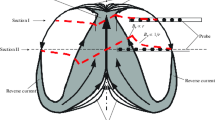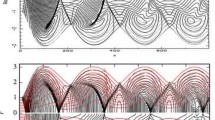Abstract
Collimated flows ejected from young stars are believed to play a vital role in the star formation process by extracting angular momentum from the accretion disk. We discuss the first experiments to simulate rotating radiatively cooled, hypersonic jets in the laboratory. A modification of the conical wire array $z$-pinch is used to introduce angular momentum into convergent flows of plasma, a jet-forming standing shock and into the jet itself. The rotation of the jet is evident in laser imaging through the presence of discrete filaments which trace the rotational history of the jet. The presence of angular momentum results in a hollow density profile in both the standing conical shock and the jet.
Similar content being viewed by others
References
Ampleford, D.J., et al.: Astrophys. Space Sci. 298, 241 (2005a)
Ampleford, D.J.: Experimental study of plasma jets produced by conical wire array z-pinches. PhD thesis, University of London (2005b)
Ampleford, D.J., et al.: Introduction of angular momentum into convergent plasma flows and radiatively cooled jets, in preparation (2006a)
Ampleford, D.J., et al.: Jet deflection by a quasi-steady-state side wind in the laboratory. Astrophysics & Space Science,DOI 10.1007/s10509-006-9238-1 (2006b)
Ampleford, D.J., et al.: AIP Conf. Proc. 808, 33 (2006c)
Bacciotti, F., et al.: Astrophys. J. 576, 222 (2002)
Balick, B., Frank, A.: Ann. Rev. Astr. Astrophys. 40, 439 (2002)
Begelman, M.C., et al.: Rev. Mod. Phys. 56, 255 (1984)
Blackman, E.G., et al.: “Distinguishing Propagation vs. Launch Physics of Astrophysical Jets and the Role of Experiments’ in this issue (2006)
Blondin, J.M., et al.: Astrophys. J. 360, 370 (1990)
Ciardi, A., et al.: Laser Part. Beams 20, 255 (2002)
Coffey, D., et al.: Astrophys. J. 604, 758 (2004)
Frank, A., et al.: Astrophys. Space Sci. 298, 107 (2005)
Hartigan, P.: Astrophys. Space Sci. 287, 111 (2003)
Kato, Y., et al.: Astrophys. J. 605, 307 (2004)
Lebedev, S.V., et al.: Astrophys. J. 564, 113 (2002)
Lebedev, S.V., et al.: Astrophys. J. 616, 988 (2004)
Lebedev, S.V., et al.: Plas. Phys. Contr. Fus. 47, B465 (2005a)
Lebedev, S.V., et al.: MNRAS 361, 97 (2005b)
Lynden-Bell, D.: MNRAS 341, 13 (2003)
Mitchell, I.H., et al.: Rev. Sci. Instruments 67, 1533 (1996)
Reipurth, B., Bally, J.: Ann. Rev. Astr. Astrophys. 39, 403 (2001)
Remington, B.A., et al.: Plas. Phys. Contr. Fus. 47, A191 (2005)
Ryutov, D.D., et al.: Astrophys. J. 518, 821 (1999)
Sherlock, M.: Ion Collisional Effects in Z-Pinch Precursor Plasma and Laboratory Astrophysical Jets, PhD thesis, University of London (2003)
Author information
Authors and Affiliations
Corresponding author
Rights and permissions
About this article
Cite this article
Ampleford, D.J., Lebedev, S.V., Ciardi, A. et al. Laboratory Modeling of Standing Shocks and Radiatively Cooled Jets with Angular Momentum. Astrophys Space Sci 307, 51–56 (2007). https://doi.org/10.1007/s10509-006-9258-x
Received:
Accepted:
Published:
Issue Date:
DOI: https://doi.org/10.1007/s10509-006-9258-x




